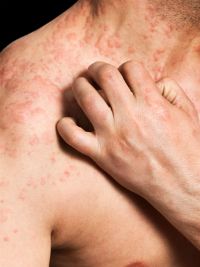Top Class Actions’s website and social media posts use affiliate links. If you make a purchase using such links, we may receive a commission, but it will not result in any additional charges to you. Please review our Affiliate Link Disclosure for more information.

Lamictal, also known by its generic name lamotrigine, is an anti-epileptic medication that has been on the market for just over 20 years. It’s approved by the FDA to treat certain types of seizures associated with epilepsy. It’s also approved as a way to delay the mood episodes of bipolar I disorder.
What Is Lamictal Rash?
A severe rash
is a known possible complication of Lamictal. Fortunately, this rash isn’t common, but when it does happen, it can be very serious. In more severe cases, Lamictal rash treatment requires hospitalization, and the most serious cases have been life-threatening or fatal.
For the most part, the more life-threatening cases of Lamictal rash occurred within two to eight weeks of initiation of Lamictal treatment. But some such cases did not begin until after the patient had taken Lamictal for several months.
Risk factors for Lamictal rash start with age: it’s much more likely to occur in young patients than in adults. There’s also some evidence that taking Lamictal in conjunction with valproate, another anti-epileptic medication, may increase the odds of Lamictal rash. Exceeding the recommended initial dosage or the recommended schedule for increasing dosage may also contribute to developing this rash.
Lamictal rash symptoms may be life-threatening, or they may be merely benign. There’s no way to reliably predict how bad the rash will be, so patients are encouraged to consult their doctor about Lamictal rash treatment at the first sign of a rash.
However, certain Lamictal rash symptoms may be indicators that the condition is progressing into something much more serious. Rash that appears above the neck or on the soft tissues such as the mucous membranes inside the eyes, nose or mouth could be a sign that the condition is developing into Stevens Johnson syndrome.
What Is Stevens Johnson Syndrome?
Stevens Johnson syndrome is a severe skin condition that most often happens as a reaction to a medication, such as Lamictal. It starts with areas of rash on the trunk and face, but soon progresses to form blisters within those areas of rash.
The blisters themselves may grow and combine to form areas of skin that peel away, exposing the sensitive underlayer of skin. The loss of skin makes the victim particularly at risk for developing infections.
SJS can also cause sores on the mucous membranes that line the inside of the eyes, mouth, genitals, or anywhere in the digestive system. The hair and nails may fall out.
Once the condition has progressed into full-blown SJS, Lamictal rash treatment will generally require hospitalization. Sometimes treatment is conducted in a hospital’s burn unit, since Lamictal rash symptoms at that stage are similar to those of severe burns. This hospitalization can go on for weeks or months, depending on how long it takes for the body to heal itself.
Those who develop SJS after taking Lamictal may have grounds to file a legal claim based on a failure to warn about that condition. SJS can leave its victims with not just substantial pain and suffering but also impaired family relationships, hefty medical bills, and lost income from being unable to work for weeks or months at a time. A Lamictal lawsuit may be able to compensate the victim for these and other losses.
Do YOU have a legal claim? Fill out the form on this page now for a free, immediate, and confidential case evaluation. The Stevens Johnson Syndrome attorneys who work with Top Class Actions will contact you if you qualify to let you know if an individual lawsuit or class action lawsuit is best for you. [In general, SJS lawsuits are filed individually by each plaintiff and are not class actions.] Hurry — statutes of limitations may apply.
ATTORNEY ADVERTISING
Top Class Actions is a Proud Member of the American Bar Association
LEGAL INFORMATION IS NOT LEGAL ADVICE
Top Class Actions Legal Statement
©2008 – 2024 Top Class Actions® LLC
Various Trademarks held by their respective owners
This website is not intended for viewing or usage by European Union citizens.
Get Help – It’s Free
Help for Victims of Stevens Johnson Syndrome
If you or a loved one were diagnosed with Stevens Johnson Syndrome (SJS) or toxic epidermal necrolysis (TEN) after taking a prescribed or over-the-counter medication, you may be eligible to take legal action against the drug’s manufacturer. Filing an SJS lawsuit or class action lawsuit may help you obtain compensation for medical bills, pain and suffering, and other damages. Obtain a free and confidential review of your case by filling out the form below.
An attorney will contact you if you qualify to discuss the details of your potential case at no charge to you.
Oops! We could not locate your form.












